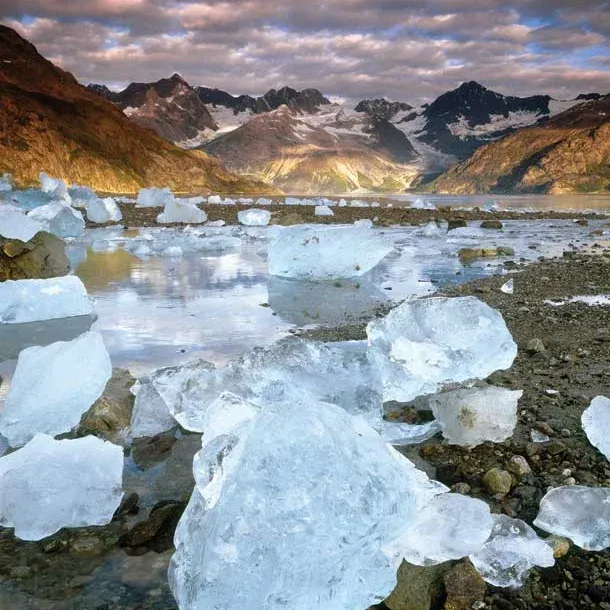Glacier Bay National Park
Glacier Bay National Park, located in southeastern Alaska, is a stunning natural wonder that showcases the beauty of glaciers, mountains, and coastal fjords. The park is home to an array of wildlife, including humpback whales, sea lions, and bald eagles. Visitors can explore the park by boat, kayak, or on foot, taking in the breathtaking scenery and the dynamic ecosystem. The park also offers opportunities for camping, fishing, and wildlife watching. With its diverse landscapes and abundant wildlife, Glacier Bay National Park is a must-see destination for nature enthusiasts and outdoor adventurers.

Glacier Bay National Park, located in the southeastern part of Alaska, is a breathtaking expanse of natural beauty that spans over 3.3 million acres. The park is known for its stunning landscapes, including towering mountains, lush forests, and of course, its iconic glaciers. It is a place where visitors can experience the raw power of nature, as well as the delicate balance that exists within this pristine wilderness.
One of the most notable features of Glacier Bay National Park is its glaciers. The park is home to over 50 glaciers, each with its own unique characteristics. The most famous of these is the Margerie Glacier, which is a massive, 21-mile long river of ice that descends from the Fairweather Range and spills into the waters of Glacier Bay. The sight of the Margerie Glacier is truly awe-inspiring, as visitors can witness massive chunks of ice breaking off and crashing into the bay below, creating a thunderous roar that reverberates through the valley. This dramatic display of nature's power is a reminder of the ever-changing landscape of Glacier Bay, as the glaciers continue to advance and recede with the ebb and flow of the tides.
In addition to the glaciers, Glacier Bay National Park is also home to a diverse array of wildlife. The park is a haven for marine mammals, including humpback whales, orca whales, sea lions, and harbor seals. Visitors to the park can often spot these magnificent creatures as they swim and play in the waters of Glacier Bay. The park is also a paradise for birdwatchers, with over 240 species of birds making their home in the park, including bald eagles, puffins, and the rare and elusive Gyrfalcon. For those interested in land animals, the park is home to brown bears, moose, and mountain goats, among other species.
The landscape of Glacier Bay National Park is a testament to the power of glaciers and the forces of erosion. The park's mountains, valleys, and fjords were all carved out by the powerful forces of ice, and today they stand as a testament to the sheer power of nature. The park's rugged terrain offers a variety of opportunities for outdoor recreation, including hiking, camping, kayaking, and wildlife viewing. The park also boasts a number of well-maintained trails, which range from easy walks to more challenging hikes that offer stunning views of the surrounding landscape.
One of the most popular activities in Glacier Bay National Park is kayaking. The park's calm, protected waters are the perfect place for paddlers of all skill levels to explore the park's stunning coastline and get up close to the park's iconic glaciers. Many visitors choose to embark on multi-day kayaking trips, which allow them to immerse themselves in the beauty and tranquility of the park and experience the thrill of camping on the shores of Glacier Bay.
For those who prefer to explore the park by boat, there are a number of tour operators that offer guided cruises through the waters of Glacier Bay. These cruises offer visitors the chance to see the park's glaciers, wildlife, and stunning landscapes from the comfort of a ship, and are a popular way for visitors to experience the park's beauty without having to navigate the waters themselves.
The park also offers a number of educational programs and ranger-led activities for visitors of all ages. These programs cover a wide range of topics, including the park's natural history, wildlife, and geology, and are a great way for visitors to learn more about the park's unique ecosystems and the importance of preserving them for future generations.
Glacier Bay National Park is also a designated UNESCO World Heritage Site, which recognizes its outstanding natural beauty and ecological significance. The park is a living laboratory for scientists and researchers, who come from around the world to study its unique ecosystems and the effects of climate change on its glaciers and wildlife. In recent years, the park has become a focal point for research on the impacts of global warming, as the retreat of its glaciers offers a stark reminder of the rapid changes occurring in the Earth's climate.
In conclusion, Glacier Bay National Park is a place of unparalleled natural beauty and ecological significance. Its stunning landscapes, diverse wildlife, and iconic glaciers make it a must-see destination for anyone interested in experiencing the power and majesty of nature. Whether you're a hiker, kayaker, wildlife enthusiast, or simply someone who appreciates the beauty of the natural world, Glacier Bay National Park offers something for everyone. It is a place that inspires awe and wonder, and one that will leave a lasting impression on all who have the privilege of visiting.




